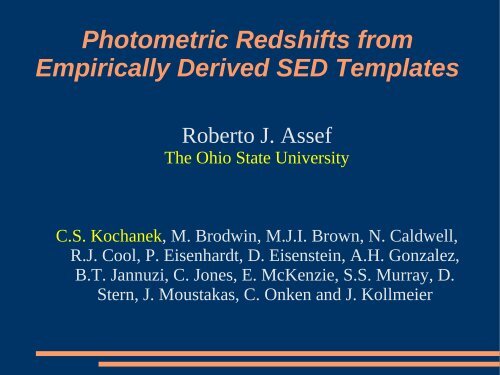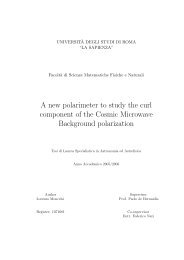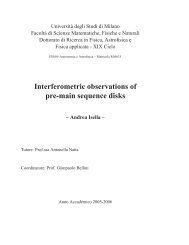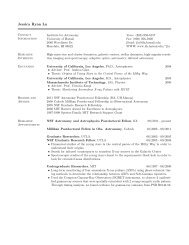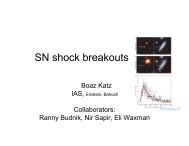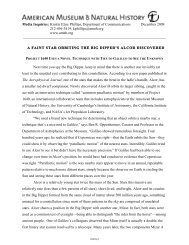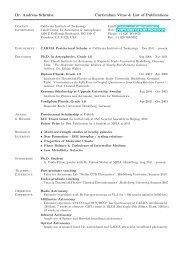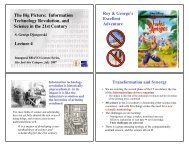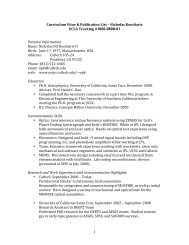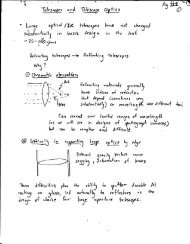Photometric Redshifts from Empirically Derived SED Templates
Photometric Redshifts from Empirically Derived SED Templates
Photometric Redshifts from Empirically Derived SED Templates
Create successful ePaper yourself
Turn your PDF publications into a flip-book with our unique Google optimized e-Paper software.
<strong>Photometric</strong> <strong>Redshifts</strong> <strong>from</strong><br />
<strong>Empirically</strong> <strong>Derived</strong> <strong>SED</strong> <strong>Templates</strong><br />
Roberto J. Assef<br />
The Ohio State University<br />
C.S. Kochanek, M. Brodwin, M.J.I. Brown, N. Caldwell,<br />
R.J. Cool, P. Eisenhardt, D. Eisenstein, A.H. Gonzalez,<br />
B.T. Jannuzi, C. Jones, E. McKenzie, S.S. Murray, D.<br />
Stern, J. Moustakas, C. Onken and J. Kollmeier
Introduction<br />
● Large and deep photometric surveys are becoming<br />
increasingly more common<br />
– SDSS<br />
– LSST<br />
– DES<br />
– Pan-STARRS, etc.<br />
● Spectroscopic follow-up is expensive<br />
● Most analysis must come <strong>from</strong> photometric data<br />
– <strong>Redshifts</strong><br />
– Spectral Classifications<br />
– K-Corrections
● Major development in photometric redshift techniques in the<br />
last decade.<br />
– Empirical methods.<br />
– <strong>SED</strong> fitting.<br />
● Empirical methods are only good within training set<br />
boundaries. Cannot do spectral classification, K-Corrections,<br />
etc.<br />
● <strong>SED</strong> fitting methods rely on spectral templates. Can do<br />
spectral analysis.<br />
– Spectral templates are empirical or come <strong>from</strong> models.<br />
– No templates reproduce mid-IR or UV reliably.<br />
● Best method would be a combination of both.
● Budavari et al. (2000) and Csabai et al. (2000) proposed a<br />
method that combines both approaches.<br />
● Idea is to fit for the templates <strong>from</strong> a broad-band photometry<br />
training set.<br />
● Training set must be deep enough in redshift to optimize<br />
wavelength coverage.<br />
● We have determined low resolution templates <strong>from</strong> NUV to<br />
mid-IR that accurately reproduce galaxy properties.<br />
– Training set <strong>from</strong> NOAO Deep Wide-Field Survey<br />
● Most results in this talk already published in Assef et al. 2008,<br />
ApJ, 676, 286.
<strong>Photometric</strong> Data<br />
● NOAO Deep Wide-Field Survey (NDWFS)<br />
– Cetus and Boötes fields<br />
● Available Imaging<br />
– Bw, R, I and K (NDWFS)<br />
– J and Ks (FLAMEX)<br />
– 4 IRAC bands (Shallow Survey, SDWFS)<br />
– z-Band (zBoötes)<br />
– FUV and NUV (GALEX)<br />
– MIPS 24µm (MAGES)<br />
– X-Ray (XBoötes)<br />
– Radio (FIRST, NVSS, WENSS)
Spectroscopic Data<br />
● AGN and Galaxy Evolution Survey (AGES,<br />
Kochanek et al. in prep.)<br />
– Low resolution spectra<br />
– ~17000 Galaxies<br />
● I
Fitting the <strong>Templates</strong><br />
● Based on the method proposed by Budavari (2000)<br />
and Csabai (2000).<br />
– Find PCA components <strong>from</strong> photometry<br />
● Assumption: Every galaxy <strong>SED</strong> is a non-negative<br />
linear combination of:<br />
– Old stellar population (Elliptical)<br />
– Continuously star-forming (Spiral)<br />
– Starburst<br />
– Post-Starburts (E+A, alternative model)<br />
● Non-negative combinations avoid unphysical<br />
<strong>SED</strong>s
Fitting the <strong>Templates</strong><br />
● Low Resolution<br />
– Each template is divided in 160 wavelength bins<br />
– Each bin is convolved with the filter band pass and fit<br />
to the data<br />
● Initial guesses<br />
– Coleman, Wu & Weedman (CWW,1980)<br />
– Bruzual & Charlot (2003) UV & mid-IR<br />
– M83 & VC1003 PAH features (Devriendt et al. 1999)<br />
● Smoothing <strong>Templates</strong><br />
– Resulting templates must be smooth<br />
● <strong>Photometric</strong> zero point / aperture corrections
Resulting <strong>Templates</strong><br />
● Significant<br />
deviations <strong>from</strong><br />
initial <strong>SED</strong>s<br />
● E has lower UV<br />
● SF templates have<br />
much higher PAHs<br />
● E+A gives a much<br />
better overall fit,<br />
but...
Photo-zs for NDWFS Galaxies<br />
● 4T slightly worse<br />
then 3T<br />
● 90% of objects<br />
within blue lines<br />
● Simple<br />
luminosity prior<br />
<strong>from</strong> LCRS<br />
luminosity<br />
function
● Error distribution has very non-gaussian tails.<br />
● When clipping to 95%, dispersion similar to 68.3% interval.<br />
● Average median deviation small.
Planned and Current Updates<br />
● GALEX and MIPS data added<br />
– Effective wavelength <strong>from</strong> 0.03 to 30µm.<br />
● Added upper<br />
limits for most bands<br />
● Deeper IRAC<br />
imaging (SDWFS)<br />
● Variable IGM<br />
absorption
AGN Template<br />
● Added an AGN template following the same<br />
procedure<br />
– Assumption: All AGNs have the same <strong>SED</strong> + variable<br />
reddening<br />
● Initial guess<br />
– Power-law (UV-optical) + black body (IR)<br />
● Goals<br />
– Photo-zs for AGNs<br />
– AGN identification<br />
– Luminosity Functions<br />
– Eddington Ratios
<strong>Templates</strong>
Photo-zs for AGNs in Extended<br />
Sources<br />
● Bright hosts<br />
provide photo-z<br />
accuracy<br />
● σ = 0.2<br />
σ 95% = 0.1<br />
● Outliers<br />
dominate the<br />
formal<br />
dispersion
Photo-zs for AGNs in Point<br />
Sources<br />
● σ = 0.75<br />
σ 95% = 0.60<br />
● <strong>SED</strong> is too flat<br />
for good photo-z<br />
● Work in<br />
progress!
Applications<br />
● AGN selection<br />
– Recover most AGNs found by other methods (IRAC<br />
colors, MIPS, X-Ray, Radio, line-ratios)<br />
– Classified ~100 new objects as AGNs in AGES data set<br />
● AGN LF<br />
– Limit to I
Summary<br />
● We have derived a basis of empirical <strong>SED</strong><br />
templates for galaxies and AGNs.<br />
● <strong>Photometric</strong> redshifts and K-corrections code is<br />
publicly available.<br />
● Accurate galaxy photo-zs can be calculated with<br />
this technique.<br />
● <strong>Templates</strong> <strong>from</strong> Assef et al. (2008) are being<br />
updated to include GALEX, MIPS and new IRAC<br />
data.


